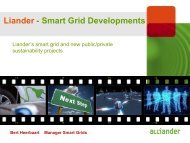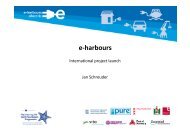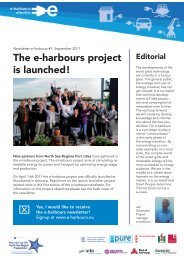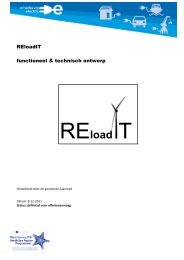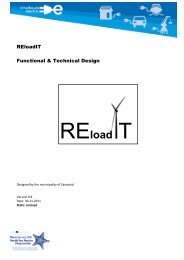renewable energy in zaanstad: from theory to practice - e-harbours
renewable energy in zaanstad: from theory to practice - e-harbours
renewable energy in zaanstad: from theory to practice - e-harbours
You also want an ePaper? Increase the reach of your titles
YUMPU automatically turns print PDFs into web optimized ePapers that Google loves.
Security of <strong>energy</strong> supply The <strong>in</strong>creas<strong>in</strong>g amount of <strong>energy</strong> generated <strong>from</strong> <strong>renewable</strong> <strong>energy</strong><br />
sources results <strong>in</strong> a more secure <strong>energy</strong> supply and less dependency<br />
of political <strong>in</strong>stable regions.<br />
Healthy environment Becom<strong>in</strong>g a CO2 neutral municipality will lead <strong>to</strong> a cleaner and<br />
healthier environment for Zaanstads residents.<br />
The Dutch government – as result of the goals set by the European Commission – wants a share of<br />
<strong>renewable</strong> <strong>energy</strong> of 14% and a reduction of CO2 emission with 20% by 2020. Zaanstad wants its<br />
municipality <strong>to</strong> be lead<strong>in</strong>g <strong>in</strong> its <strong>energy</strong> policy with regard <strong>to</strong> the national policy and other<br />
communities. That is why Zaanstad has set the ambitious goal of be<strong>in</strong>g a CO2 neutral municipality by<br />
2020. This means that the yearly average CO2 emission caused by <strong>energy</strong> consumption with<strong>in</strong> the<br />
municipality should equal zero 1 .<br />
Zaanstad will be def<strong>in</strong>ed as climate neutral if the <strong>to</strong>tal yearly average CO2-emission as result of<br />
<strong>energy</strong> consumption with<strong>in</strong> its municipality boundaries will equal zero.<br />
2.3 ENERGY DEMAND<br />
To create a clear vision and strategy on achiev<strong>in</strong>g CO2 neutrality of its <strong>energy</strong> demand, it is important<br />
<strong>to</strong> have a clear overview of the current <strong>energy</strong> consumption of Zaanstad. In this chapter an overview<br />
of the electricity and gas consumption of Zaanstads <strong>to</strong>tal municipality will be given, even as the<br />
<strong>energy</strong> consumption of the different sec<strong>to</strong>rs 2 . Besides that the <strong>energy</strong> consumption of the municipal<br />
organization will be reviewed, which <strong>in</strong>clude all the municipal properties.<br />
Municipality<br />
The <strong>to</strong>tal <strong>energy</strong> consumption of Zaanstads municipality has been estimated at 11.1 PJ/year 3 [1].<br />
Figure 2 shows a distribution of Zaanstads <strong>energy</strong> consumption <strong>in</strong> different types of <strong>energy</strong>. The<br />
largest <strong>energy</strong> consumers are respectively natural gas (49%), transport fuels (28%) and electricity<br />
(21%). Figure 2 shows a distribution of the <strong>energy</strong> consumption of Zaanstad <strong>in</strong> different sec<strong>to</strong>rs.<br />
Figure 2. Overview of the distribution of the <strong>energy</strong> consumption (<strong>in</strong> PJ/year) of Zaanstad <strong>in</strong> different types of <strong>energy</strong> (left)<br />
and different sec<strong>to</strong>rs (right)<br />
1 The emission of other greenhouse gasses will be neglected<br />
2 The <strong>energy</strong> demand of Zaanstad has been estimated by HVC CQ team [1].<br />
3 This estimation is based on data <strong>from</strong> 2007 and 2008<br />
8



